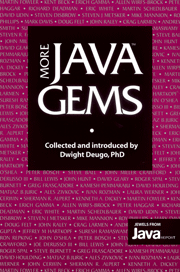Book contents
- Frontmatter
- Contents
- INTRODUCTION
- GETTING STARTED WITH JAVA
- MIGRATING TO JAVA
- TECHNIQUES 101
- MODELING AND PATTERNS
- THE CONCEPTUAL MODEL: WHAT'S THE OBJECT?
- REFINING SKILLS FOR EXPRESSIVE CONCEPTUAL MODELS
- DISTRIBUTED OBSERVER CHAINS
- EVENT NOTIFIER: A PATTERN FOR EVENT NOTIFICATION
- ANALYSIS PATTERNS
- JAVA IN A DISTRIBUTED WORLD
- THREADS
- USER INTERFACES
- SECURITY
- TESTING
- PERFORMANCE
- REALITY CHECK
- INDEX
EVENT NOTIFIER: A PATTERN FOR EVENT NOTIFICATION
Published online by Cambridge University Press: 06 July 2010
- Frontmatter
- Contents
- INTRODUCTION
- GETTING STARTED WITH JAVA
- MIGRATING TO JAVA
- TECHNIQUES 101
- MODELING AND PATTERNS
- THE CONCEPTUAL MODEL: WHAT'S THE OBJECT?
- REFINING SKILLS FOR EXPRESSIVE CONCEPTUAL MODELS
- DISTRIBUTED OBSERVER CHAINS
- EVENT NOTIFIER: A PATTERN FOR EVENT NOTIFICATION
- ANALYSIS PATTERNS
- JAVA IN A DISTRIBUTED WORLD
- THREADS
- USER INTERFACES
- SECURITY
- TESTING
- PERFORMANCE
- REALITY CHECK
- INDEX
Summary
In our complex world, events are constantly occurring. Any one person is only interested in a very small subset of all these events, so humans have worked out ways of getting just the information of interest, which works to a degree. We may periodically check to see if the event has occurred, or we ask someone to notify us when the event occurs. Often there is more than one source of a particular type of event such as disaster-related events, but we do not typically care about who notifies us, just that the event has occurred. Ideally, we would subscribe to just those types of events in which we are interested and be notified of them when they occur.
Event notification is a useful communication paradigm in computing systems as in real life. This article documents general event notification in the form of a design pattern, which provides a useful way of exposing readers to the important concepts and issues involved in event notification, and provides a language-neutral pattern for implementing event notification in a variety of scenarios. Concurrently, we discuss design issues using examples as appropriate to demonstrate effective use of event notification. Diagrams use the Unified Modeling Notation (UML) (see Unified Modeling Language User Guide, Booch, G. et al., Addison-Wesley, 1997).
- Type
- Chapter
- Information
- More Java Gems , pp. 131 - 154Publisher: Cambridge University PressPrint publication year: 2000
- 6
- Cited by



